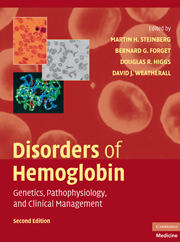Book contents
- Frontmatter
- Contents
- List of Contributors
- Foreword, by H. Franklin Bunn
- Preface
- Introduction, by David J. Weatherall
- SECTION ONE THE MOLECULAR, CELLULAR, AND GENETIC BASIS OF HEMOGLOBIN DISORDERS
- SECTION TWO PATHOPHYSIOLOGY OF HEMOGLOBIN AND ITS DISORDERS
- SECTION THREE α THALASSEMIA
- SECTION FOUR THE β THALASSEMIAS
- SECTION FIVE SICKLE CELL DISEASE
- SECTION SIX OTHER CLINICALLY IMPORTANT DISORDERS OF HEMOGLOBIN
- 24 Unstable Hemoglobins, Hemoglobins with Altered Oxygen Affinity, Hemoglobin M, and Other Variants of Clinical and Biological Interest
- 25 Dyshemoglobinemias
- SECTION SEVEN SPECIAL TOPICS IN HEMOGLOBINOPATHIES
- SECTION EIGHT NEW APPROACHES TO THE TREATMENT OF HEMOGLOBINOPATHIES AND THALASSEMIA
- Index
- Plate section
- References
24 - Unstable Hemoglobins, Hemoglobins with Altered Oxygen Affinity, Hemoglobin M, and Other Variants of Clinical and Biological Interest
from SECTION SIX - OTHER CLINICALLY IMPORTANT DISORDERS OF HEMOGLOBIN
Published online by Cambridge University Press: 03 May 2010
- Frontmatter
- Contents
- List of Contributors
- Foreword, by H. Franklin Bunn
- Preface
- Introduction, by David J. Weatherall
- SECTION ONE THE MOLECULAR, CELLULAR, AND GENETIC BASIS OF HEMOGLOBIN DISORDERS
- SECTION TWO PATHOPHYSIOLOGY OF HEMOGLOBIN AND ITS DISORDERS
- SECTION THREE α THALASSEMIA
- SECTION FOUR THE β THALASSEMIAS
- SECTION FIVE SICKLE CELL DISEASE
- SECTION SIX OTHER CLINICALLY IMPORTANT DISORDERS OF HEMOGLOBIN
- 24 Unstable Hemoglobins, Hemoglobins with Altered Oxygen Affinity, Hemoglobin M, and Other Variants of Clinical and Biological Interest
- 25 Dyshemoglobinemias
- SECTION SEVEN SPECIAL TOPICS IN HEMOGLOBINOPATHIES
- SECTION EIGHT NEW APPROACHES TO THE TREATMENT OF HEMOGLOBINOPATHIES AND THALASSEMIA
- Index
- Plate section
- References
Summary
INTRODUCTION
Mutations of hemoglobin can be polymorphic (>1% of a population), like HbS, HbE, HbC, and the thalassemias, or rare. Our first edition listed 750 unique hemoglobin variants; this number is now more than 1,000. In this chapter we address rare mutations. Some are associated with clinical disease; others are interesting solely for the biological principles they illustrate. A current listing of variant human hemoglobins is maintained in the HbVar database at http://globin.cse.psu.edu/, and the journal Hemoglobin (Taylor & Francis, Philadelphia) is a rich source for reports of new variants. Both are invaluable resources for clinicians and investigators with interests in unusual hemoglobin disorders.
Globin gene mutations, which include nearly every class of mutation so far described, except trinucleotide repeats and other nucleotide expansions associated with neuromuscular disorders, provided an early catalog of the mutations that can cause genetic disease. Clinically important but rare mutants affect hemoglobin stability causing premature red cell destruction; interfere with normal oxygen binding kinetics producing erythrocytosis; and permit heme iron oxidation, causing cyanosis. Most rare variants have no phenotype and are of biological and diagnostic interest only.
Comparatively few globin residues are critical for maintaining the structural integrity and functional performance of the molecule (Chapter 6). Hemoglobin gene mutations are, as a rule, not associated with hematological or clinical abnormalities and escape detection, especially when they are chromatographically silent.
Large-scale population screening programs have defined the worldwide prevalence of medically important hemoglobinopathies and thalassemias.
- Type
- Chapter
- Information
- Disorders of HemoglobinGenetics, Pathophysiology, and Clinical Management, pp. 589 - 606Publisher: Cambridge University PressPrint publication year: 2009
References
- 5
- Cited by



